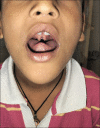Bifid Uvula-An Enigma
- PMID: 37654280
- PMCID: PMC10466618
- DOI: 10.4103/jpbs.jpbs_464_22
Bifid Uvula-An Enigma
Abstract
Facial development involves an intricate regulatory mechanism that accounts for numerous craniofacial abnormalities, common being orofacial clefts. Although cleft in the secondary palate accounts for one-third of orofacial clefts stills remains an under-researched domain. Hence, in this work, the authors put forth two non-syndromic, asymptomatic cleft uvulae reported among bimodal male patients of the Indian-Asiatic population who came up for dental screening. Most of the time, isolated/asymptomatic cleft uvula patients will be reluctant to further investigations and treatment. Although bifid uvula looks benign in most patients, it may sometimes be associated with catastrophic complications. To conclude, whenever bifid uvula is an incidental finding, it is the responsibility of the healthcare worker to plan a thorough patient workup as a primary preventive measure to rule out any complications whenever feasible. It can help us overcome many future unforeseen sequelae and emergency management due to bifid uvula.
Keywords: Bifid; cleft uvula; non-syndromic; uvula.
Copyright: © 2023 Journal of Pharmacy and Bioallied Sciences.
Conflict of interest statement
There are no conflicts of interest.
Figures
References
-
- Back GW, Nadig S, Uppal S, Coatesworth AP. Why do we have a uvula?:Literature review and a new theory. Clin Otolaryngol Allied Sci. 2004;29:689–93. - PubMed
-
- Stanier P, Moore GE. Genetics of cleft lip and palate:Syndromic genes contribute to the incidence of non-syndromic clefts. Human Mol Genet. 2004;13((suppl_1)):R73–81. - PubMed
-
- Wiske CP, McGregor AJ. Say Ah:The unexpected uvula. Emerg Med News. 2012;34 doi:10.1097/01. EEM.0000414681.09689.6e.
Publication types
LinkOut - more resources
Full Text Sources
Miscellaneous


